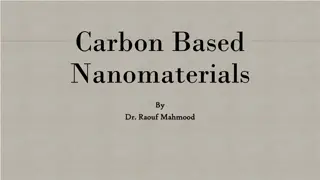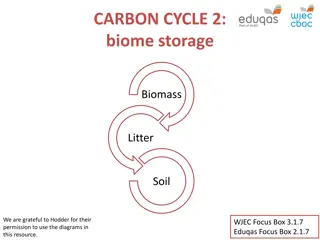Overview of Carbon Accounting in the UK: Progress and Challenges
The project aims to test the feasibility of producing SEE-EEA style Carbon Accounts, assess data sources, and lay a path for further development. Carbon accounting in SEE-EEA identifies carbon as a key theme, supporting ecosystem measurement. The UK's carbon accounts cover geosphere, biosphere, oceans, atmosphere, and economy accumulations. Geocarbon stock and flow estimates focus on coal, oil, and gas categories, excluding limestone and carbonate rocks. Challenges include defining geocarbon boundary stores for ecosystem accounting.
Download Presentation

Please find below an Image/Link to download the presentation.
The content on the website is provided AS IS for your information and personal use only. It may not be sold, licensed, or shared on other websites without obtaining consent from the author. Download presentation by click this link. If you encounter any issues during the download, it is possible that the publisher has removed the file from their server.
E N D
Presentation Transcript
Carbon Accounting in the UK: An overview of progress and issues Brendan Freeman, Office for National Statistics (UK) 22nd Meeting of the London Group on Environmental Accounting Oslo, 28-30 September
Aims of the project Test the feasibility of producing SEEA-EEA style Carbon Accounts Assess current data sources Test compatibility of classification systems Produce provisional and partial estimates of stocks and flows of carbon within UK Layout path forward for development of the accounts
Carbon accounting in SEEA SEEA-EEA identifies carbon as one of four cross-cutting themes that frame our view of ecosystems. Taking a thematic approach : Enables carbon to be accounted for in its own right Supports measurement of ecosystem condition/flows Accounting for carbon stocks complements measurement within the Inter-governmental Panel on Climate Change (IPCC) framework
Carbon Cycle: Scope of UK carbon accounts Stocks and flows of the carbon cycle give the underlying context for carbon accounting UK Coverage IN Geosphere, Biosphere Out Oceans, Atmosphere, Accumulations in the Economy
Geocarbon Stock and flow estimates for the geocarbon categories of coal, oil and gas were presented in the accounts. Limestone and carbonate rocks excluded from study at this stage. The broadest measure available for the selected geocarbon resources was adopted, while still attempting to align as closely as is possible to SEEA concepts.
Issue 1. How to define the boundary of geocarbon stores for the purposes of ecosystem accounting? Where stocks are considerable but large quantities are unlikely to be released by anthropogenic or natural activity within a reasonable time frame, it is questionable whether there is any point in recording the relevant amounts in the accounts.
Biocarbon Primary focus of the UK carbon accounts is on terrestrial habitats/ ecosystems. Can be broadly classified into: organic soil carbon, vegetation (biomass) carbon carbon contained in animals living within the ecosystems; and inorganic carbon contained in soils
Carbon accounts link to UK ecosystem accounts Support estimates of: extent (MtC), condition (carbon content per Km2) service flows (wood, carbon sequestration).
Combining classifications Stock estimates based on UK field survey data. Flows are generally taken from the Land Use, land use change and forestry (LULUCF) section if the Greenhouse Gas Emissions. This has a classification which accords to the Intergovernmental Panel on Climate Change (IPCC) reporting guidelines.
Issue 2 Ensuring no loss of coverage when aligning SEEA habitat classes to IPCC land use classes Guidance on mapping between IPCC LULUCF Classifications and SEEA-EEA habitat classifications is limited. The LULUCF classification does not include marine ecosystems including those intertidal areas recorded within the Coastal Margins Land Cover category.
Issue 3. Identifying and isolating carbon flows within the LULUCF class of GHG emissions Considerable difficulty in correctly identifying and isolating flows from natural processes, with the LULUCF source category: Other, harvested wood products being one example. Reported on a net (emissions to, less removals from, the atmosphere) basis and are calculated based on estimated annual stock changes.
Issue 3. cont LULUCF does not distinguish between soil and biomass carbon, so estimates of changes in flows need to be combined together.
Thank you! Questions, comments and suggestions welcomed























